HELLO,HIVE!
So, we left Hampi and after about 4 hours arrived to inspect the cave temples of Badami. Badami is a small town with a population of 25-30 thousand people in the state of Karnataka, Bagalkot district, India.
Why did we come to this small town? What's so interesting about it?
The thing is that here, among other things, there are 4 cave temples, carved in high rocks in the vicinity of the South Fort (there is also the North Fort). By the way, tourists are not allowed to the South Fort. It stands on top of a red sandstone cliff. According to rumors, one of the tourists decided to check whether he could fly like a bird, since then tourists have not been allowed into the fort, but this is not certain.
Sometime in the 6-8 centuries Badami was called Vatapi and was the capital of the Chalukya dynasty, cave temples are a legacy of those times. At this time, the Roman Empire fell in Europe, the Great Migration of Nations took place, and the Turks and Vikings came to Europe, the kingdom of the Franks appeared, well, so as to understand that this was the early Middle Ages. Why Vatapi? According to legend, the local rocks are the demon brothers Ilvala and Vatapi. The demons mocked the brahmanas in a particularly sophisticated way. Ilvala turned Vatapi into a goat. The brahmins ate the goat meat offered to Ilvala. And then the big oops happened. Vatapi turned back into a demon right inside the brahmanas and the poor fellows burst from the inside like balloons filled with blood. Stephen King would love a story like this!
But Vatapi ended badly. A certain sage Agastya (after whom an artificial lake near the rocks is named, we will talk about this lake later) had a good metabolism and managed to digest Vatapi before Ilvala uttered the spell to turn back into a demon. Here's a story. Perhaps these are some of the oldest temples in India. By the way, in the south-west of Karnataka, the ancient language Kannada (Dravidian language) is still spoken, about 38 million Indians speak it. And there are 23 (!) Official languages in India in total! The people of Goa also have their own Konkani language.
Today I will talk about one of the caves, namely the first cave, which is dedicated to the god Shiva. Presumably, the temple was built in the 6th century. Shiva is one of the most revered gods in India. For us, he is just the god Shiva, and in India he has 108 names and epithets! “Terrible”, “Beautiful”, “King of the lingam” (yes, there is a lingam inside the cave, oops, spoiler), “Death conqueror”, etc. Our comfortable bus stopped at the site. We take water (in the heat it is necessary to carry a bottle of water with you, you cannot buy it everywhere), cameras, caps and go out. By the way, a Hindu temple is visible in the background in the photo. Immediately striking is the fact that there are an abundance of Islamic mosques.
Well, okay, not abundance. but there are definitely 4 mosques. And they relatively quietly coexist with Hindu and Buddhist temples.
A very exotic and beautiful sight! I already like it here!
The guide gives the tickets to the guards and we go up the steps. You don't need to go far, the 1st cave temple is literally a stone's throw from the entrance. The steps lead up directly to the temple.
The view from here is so-so, but everything is just beginning! The admission ticket is rumored to cost $ 5 for white legged wallets, for Indians something like 5 rupees. There is no lighting in the caves, and therefore it is worth visiting them only in the daytime, in the dark you can damage yourself. And what is there to see in the dark?
Of course, our monkey buddies live here in the rocks. It is impossible not to take pictures of such cute and funny monkeys.
Even in the holes on the rock, palm trees can grow! And again we see the traces of holes for crushing the sandstone rock.
..to be continued..
Also verließen wir Hampi und kamen nach ungefähr 4 Stunden an, um die Höhlentempel von Badami zu inspizieren. Badami ist eine kleine Stadt mit 25 bis 30.000 Einwohnern im indischen Bundesstaat Karnataka im Distrikt Bagalkot.
Warum sind wir in diese kleine Stadt gekommen? Was ist daran so interessant?
Die Sache ist, dass es hier unter anderem 4 Höhlentempel gibt, die in der Nähe des Südforts in hohe Felsen gehauen sind (es gibt auch das Nordfort). Touristen dürfen übrigens nicht ins South Fort. Es steht auf einer Klippe aus rotem Sandstein. Gerüchten zufolge beschloss einer der Touristen zu prüfen, ob er wie ein Vogel fliegen könne, seitdem dürfen Touristen das Fort nicht mehr betreten, aber das ist nicht sicher.
Irgendwann in den 6-8 Jahrhunderten wurde Badami Vatapi genannt und war die Hauptstadt der Chalukya-Dynastie. Höhlentempel sind ein Erbe dieser Zeit. Zu dieser Zeit fiel das Römische Reich in Europa, die große Völkerwanderung fand statt, und die Türken und Wikinger kamen nach Europa, das Reich der Franken erschien, um zu verstehen, dass dies das frühe Mittelalter war. Warum Vatapi? Der Legende nach sind die lokalen Felsen die Dämonenbrüder Ilvala und Vatapi. Die Dämonen verspotteten die Brahmanen auf besonders raffinierte Weise. Ilvala verwandelte Vatapi in eine Ziege. Die Brahmanen aßen das Ziegenfleisch, das Ilvala angeboten wurde. Und dann passierten die großen Hoppla. Vatapi verwandelte sich wieder in einen Dämon direkt in den Brahmanen und die armen Kerle platzten von innen wie mit Blut gefüllte Luftballons. Stephen King würde eine solche Geschichte lieben!
Aber Vatapi endete schlecht. Ein gewisser Weiser Agastya (nach dem ein künstlicher See in der Nähe der Felsen benannt ist, wir werden später über diesen See sprechen) hatte einen guten Stoffwechsel und schaffte es, Vatapi zu verdauen, bevor Ilvala den Zauber aussprach, sich wieder in einen Dämon zu verwandeln. Hier ist eine Geschichte. Vielleicht sind dies einige der ältesten Tempel in Indien. Übrigens wird im Südwesten von Karnataka immer noch die alte Sprache Kannada (dravidische Sprache) gesprochen, etwa 38 Millionen Inder sprechen sie. Und es gibt 23 (!) Amtssprachen in Indien! Die Menschen in Goa haben auch ihre eigene Konkani-Sprache.
Heute werde ich über eine der Höhlen sprechen, nämlich die erste Höhle, die dem Gott Shiva gewidmet ist. Vermutlich wurde der Tempel im 6. Jahrhundert erbaut. Shiva ist einer der am meisten verehrten Götter in Indien. Für uns ist er nur der Gott Shiva und in Indien hat er 108 Namen und Beinamen! "Schrecklich", "Schön", "König des Lingam" (ja, es gibt einen Lingam in der Höhle, oops, Spoiler), "Todeseroberer" usw. Unser komfortabler Bus hielt vor Ort. Wir nehmen Wasser (in der Hitze ist es notwendig, eine Flasche Wasser mitzunehmen, man kann es nicht überall kaufen), Kameras, Kappen und gehen aus. Im Hintergrund ist auf dem Foto übrigens ein Hindu-Tempel zu sehen. Sofort auffällig ist die Tatsache, dass es eine Fülle islamischer Moscheen gibt. Okay, nicht im Überfluss. aber es gibt definitiv 4 Moscheen. Und sie koexistieren relativ leise mit hinduistischen und buddhistischen Tempeln. Ein sehr exotischer und schöner Anblick! Mir gefällt es hier schon! Der Führer gibt den Wachen die Tickets und wir gehen die Stufen hinauf. Sie müssen nicht weit gehen, der 1. Höhlentempel ist buchstäblich nur einen Steinwurf vom Eingang entfernt. Die Stufen führen direkt zum Tempel. Die Aussicht von hier ist so lala, aber alles fängt gerade erst an! Es wird gemunkelt, dass die Eintrittskarte für Brieftaschen mit weißen Beinen 5 US-Dollar kostet, für Inder etwa 5 Rupien. In den Höhlen gibt es keine Beleuchtung, und deshalb lohnt es sich, sie nur tagsüber zu besuchen. Im Dunkeln können Sie sich selbst Schaden zufügen. Und was gibt es im Dunkeln zu sehen?
Natürlich leben unsere Affenfreunde hier in den Felsen. Es ist unmöglich, solche süßen und lustigen Affen nicht zu fotografieren.
Sogar in den Löchern auf dem Felsen können Palmen wachsen! Und wieder sehen wir die Spuren von Löchern zum Zerkleinern des Sandsteinsteins.
..Fortsetzung folgt..

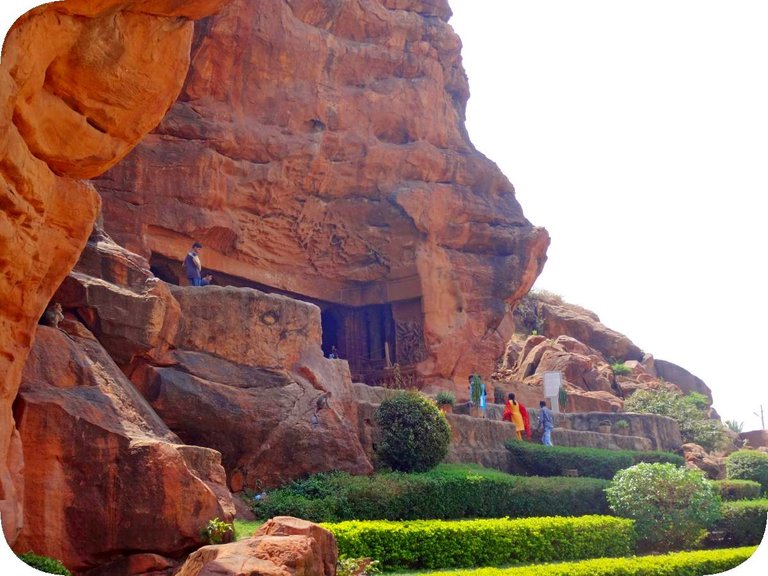
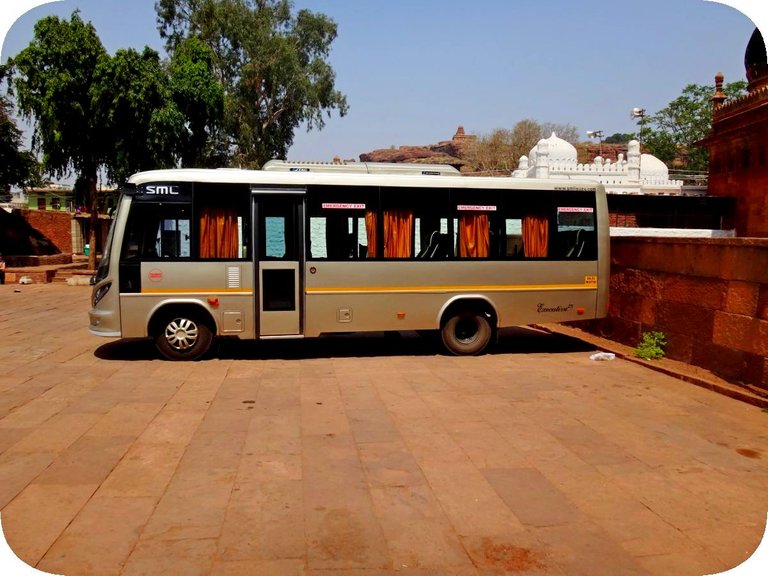

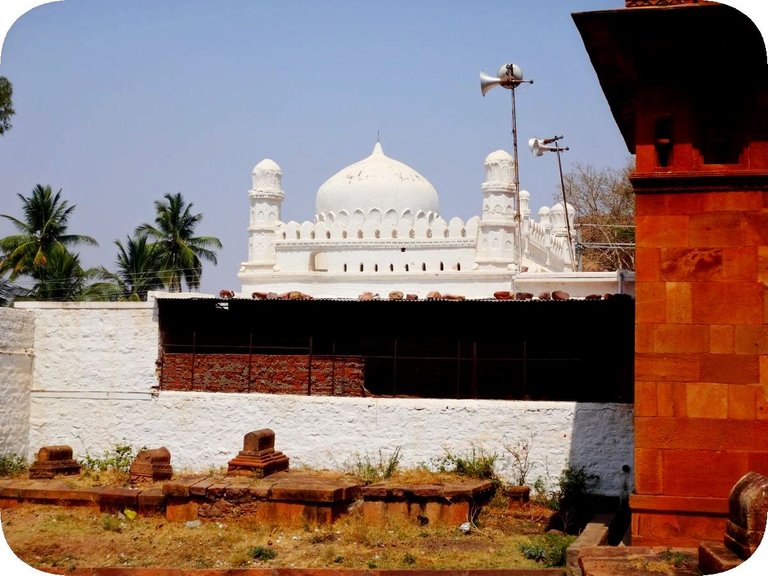


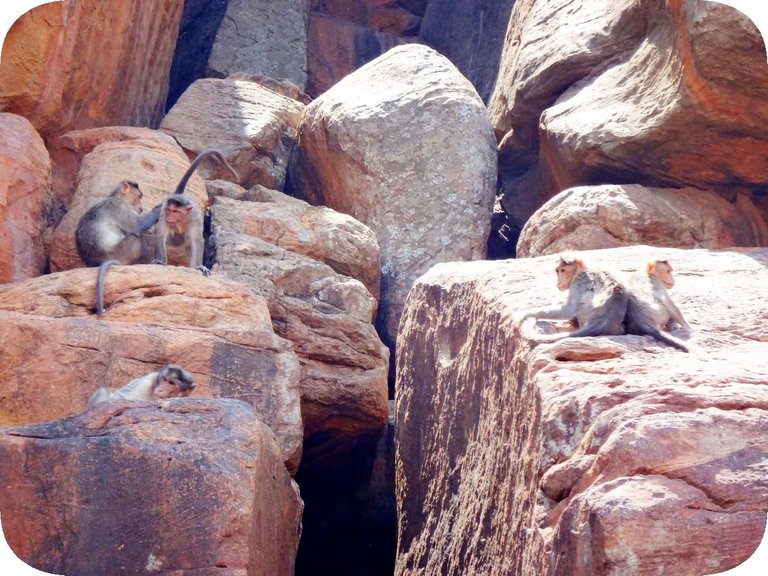
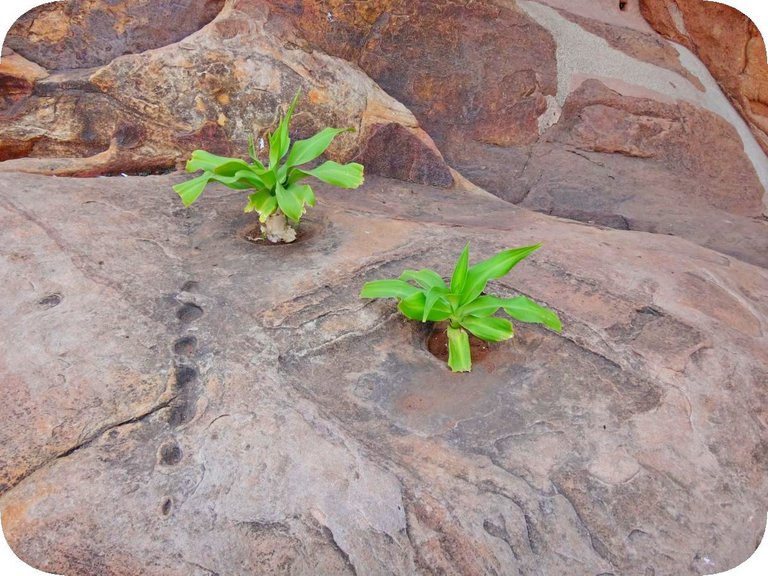
Du hast ein Upvote von mir bekommen, diese soll die Deutsche Community unterstützen. Wenn du mich unterstützten möchtest, dann sende mir eine Delegation. Egal wie klein die Unterstützung ist, Du hilfst damit der Community. DANKE!
Caves used over the years it is amazing to see still being looked after and maintained in the way people anticipated using them, always a very different atmosphere to man made structures.
Nice photography presenting all the different religious buildings in the region that co-exists, and of course the monkey business taking over the region as well.
@tipu curate
Upvoted 👌 (Mana: 9/27) Liquid rewards.
This post has been manually curated by @codingdefined from Indiaunited community. Join us on our Discord Server.
Do you know that you can earn a passive income by delegating to @indiaunited. We share 80 % of the curation rewards with the delegators.
Here are some handy links for delegations: 100HP, 250HP, 500HP, 1000HP.
Read our latest announcement post to get more information.
Please contribute to the community by upvoting this comment and posts made by @indiaunited.
Hey what a great post! I'm part of the @Pinmapple curation team and are dedicated to curate travel content on Hive. Your post would be a great oone to pin on Pinmapple, the Hive travel map https://pinmapple.com/ for greater exposure and support. Just click on the 'get code' at the top of the map and follow the instructions or check out the FAQ to get your post on the map. Hope to see you soon!
You're also welcome to join our Haveyoubeenhere community https://peakd.com/c/hive-163772 and post your travel posts from there. Pinning your post on Pinmapple not only increases your post exposure, you may also get greater support from Pinmapple if you're curated by us. You can find out more about it in this post here
https://peakd.com/hive-163772/@steemitworldmap/good-bye-from-steemitworldmap
Hope to see you soon